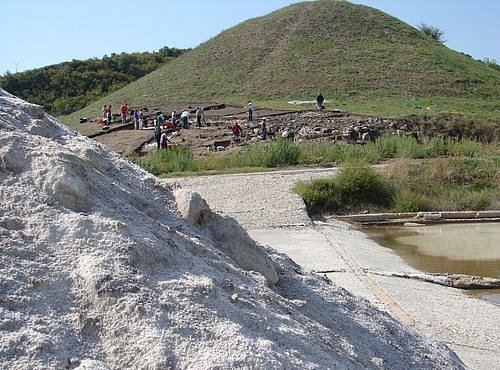EUROPE’S OLDEST CITY IS 7 THOUSAND YEARS OLD. IT IS LOCATED IN BULGARIA

Archaeologists have found the remains of a city with two-storey houses, shrines and gates in eastern Bulgaria. What allowed such a flourishing?
Archaeologists have discovered a prehistoric city in eastern Bulgaria that could be the oldest in Europe. It is located around a salt mine, and this could explain the origin of other monuments discovered in the region. AFP reports.
Quite an advanced civilisation
Archaeologists have discovered the remains of two-storey houses, shrines and one gate, as well as a bastion and three walls. According to the radiocarbon method, they date back to the Middle and Older Eneolithic, from 4700 to 4200 BC. A small necropolis, or city of the dead, was also discovered here this year, which scientists have yet to explore.
But archaeologists have only recently concluded that the fortified site, with a population of about 350, a religious and commercial centre, fits the criteria of a prehistoric city. “It’s an admirable site… It’s the work of several generations of archaeologists,” stresses Nikolov, who also laments the chronic lack of state funding, which is compensated by private donations. The results of the research are being analysed by a British anthropologist, a Japanese ceramics expert and a German team tasked with dating the finds.
Look for salt behind everything
“At a time when man knew neither the wheel nor the cart, these people moved huge stones and built massive walls. Why? What was there to hide? Salt?” Nikolov asks. Provadia-Solnitsata became what it was, thanks to the huge salt reserves in the Black Sea region, the largest in the Balkans and the only one whose exploitation dates back to the sixth millennium BC, the expert says.
“This is the first time that archaeologists have discovered traces of salt production in such an ancient period in Southeastern Europe and Western Anatolia, and what they have managed to prove thanks to scientific and archaeological evidence,” Bachvarov specifies.
Salt mines still exist today, but their value is quite different. “Salt was a precious commodity between the seventh millennium and the sixth century BC because it was both essential in everyday life and a barter product, a kind of currency,” explains Nikolov.
Salt mining at the site began around 5500 BC, when people started boiling water from salty sources in their ovens, the scientist says. Salt production was transferred off-site in the late sixth millennium, allowing productivity to increase. “Around 5500 BC, a single kiln at Provadia-Solnitsata produced 25 to 30 kilograms of dry salt; by 4700 to 4500 BC, the kiln’s output was already 4,000 to 5,000 kilograms. This was at a time when salt was as rare as gold. You can imagine what that meant,” he points out.
The salt trade gave the city’s inhabitants enormous economic power, which may explain the existence of gold treasures from 4300 BC found in 1972 in a necropolis near Varna, Nikolov says.
The “Varna Treasure”, weighing 6.5 kilograms, contained over 3,000 pieces of jewelry and religious objects and is internationally recognized as the oldest worked gold in the world. The discovery has raised questions about the ancient civilisations that inhabited Bulgaria before the Thracians and how a poor agricultural area could hide such wealth.
Source: National Geographic
Author: Editor | Published: ČTK 05.06.2020
Opening photo: International Institute of Anthropology, Bulgaria
